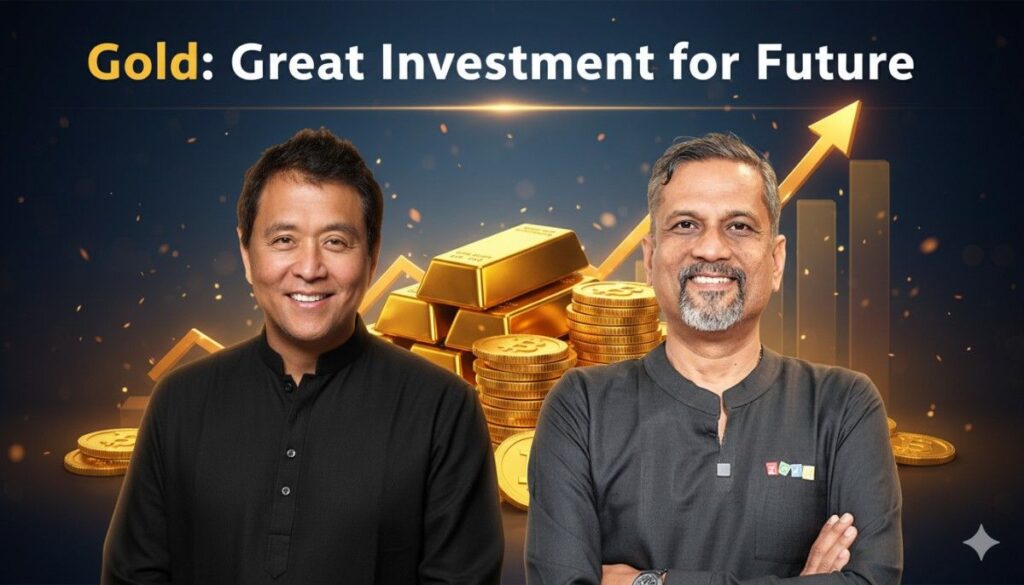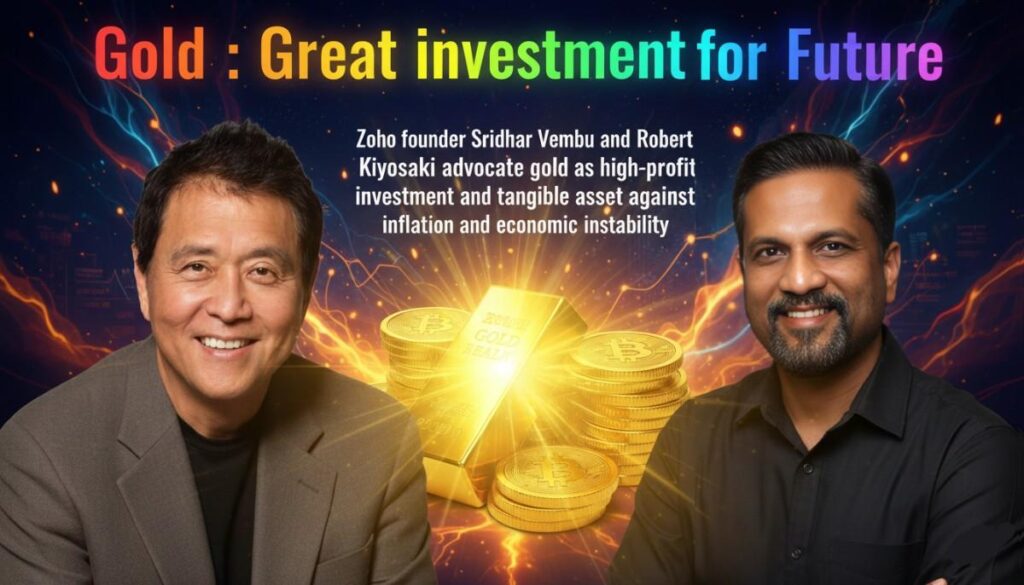When someone says “Gold : Great investment for Future”, what does that really mean? In recent times, two prominent figures — Zoho founder Sridhar Vembu and best-selling investor author Robert Kiyosaki — have again highlighted gold as a preferred asset. According to them, gold is not just a speculative bet, but a hard, tangible asset that resists inflation and preserves wealth. But is gold truly on the rise in the world today? In this article, we explore their logic, examine global gold price trends, and offer insights into whether gold makes sense as a future investment.
Table of Contents

Sridhar Vembu’s Take: Gold Over Crypto, Gold as “Insurance”
Sridhar Vembu — the founder and former CEO (now Chief Scientist) of Zoho Corporation — recently reaffirmed his long-held belief in gold. In a post on X (formerly Twitter), he said:
“I have long been in the ‘gold as insurance against currency debasement’ camp, for over 25 years now. Over the long term, gold has held its purchasing power … I am not interested in crypto.” Moneycontrol
Some key points from Vembu’s view:
- He treats gold as insurance — a way to protect against loss of value in paper currencies.
- He emphasizes that over decades, gold has preserved purchasing power, especially relative to things like oil or more volatile assets.
- He is dismissive of cryptocurrencies for this purpose, pointing to their volatility, lack of intrinsic backing, and speculative nature.
Vembu’s perspective is grounded in a conservative view of money and assets. While he is a tech entrepreneur, he does not see digital coins or speculative tokens as reliable stores of value when the financial system is under stress.
Robert Kiyosaki’s View: Gold, Silver, and Hard Assets over Fiat Money
Robert Kiyosaki — author of Rich Dad Poor Dad — has long been vocal about his distrust of fiat currencies (like the U.S. dollar) and his preference for tangible assets such as gold, silver, and real estate. Wikipedia His general message:
- Paper (fiat) money loses value — central banks “print money,” causing inflation and erosion of purchasing power.
- Gold and silver, being physical and limited, act as a hedge or protection when currencies weaken.
- He often issues strong predictions: at times, Kiyosaki has forecasted gold could rise to $25,000 per ounce, silver to $70 (or more).
- Yet, he is not blind to risks. On some occasions, he warns that bubbles may burst and that when asset prices fall, that is the time to buy.
For example, he has said:
“When bubbles bust, odds are gold, silver, and Bitcoin will bust too. … If prices … crash … I will be buying.” Business Today
Kiyosaki’s style is bold and provocative. He uses strong projections and warnings to emphasize that time may run out for preserving value via fiat money. His message is consistent: invest in “real” or “hard” assets — gold being a central pillar of that philosophy.

Why They Prefer Gold: The Appeal of Hard, Tangible Assets
Let’s put together what both Sridhar Vembu and Robert Kiyosaki are getting at, and why gold features so centrally in their thinking.
1. Tangible and Non-Counterparty
Gold is a physical asset. Unlike a claim on a bank or a digital token whose value depends on someone else’s promise, gold exists in your hand (or your vault). It is non-counterparty — you don’t depend on someone else’s balance sheet to back it.
2. Limited Supply
The total amount of gold in the world is finite. New gold is mined slowly, and mining costs are high. That acts as a natural supply constraint.
3. Historical Store of Value
Over long periods, gold has preserved value through wars, currency collapses, and economic crises. In many cases, when paper currencies lost worth, gold still retained buying power.
4. Hedge Against Inflation & Currency Depreciation
When governments print money, inflation tends to rise and the value of paper money falls. Gold, being outside that monetary system, tends to move opposite to currency value. That’s why many see gold as a natural hedge.
5. Safe Haven in Times of Crisis
During economic panic, geopolitical risk, or financial system stress, investors often flee to gold as a “safe harbor.” The demand rises in troubled times.
6. Diversification
Gold often behaves differently from stocks and bonds. In a portfolio, a modest allocation to gold can reduce overall risk or volatility.
Thus, when Vembu and Kiyosaki call gold a “hard, tangible asset that retains value against inflation and instability”, they are tapping into these core arguments.
Is Gold Rate Increasing Worldwide?
Now, theory is one thing. But what is happening in real markets? Are global gold rates rising? The short answer: yes, gold prices are climbing strongly in many parts of the world, driven by macroeconomic stress, inflation, weak real interest rates, and investor demand.
Here’s an up-to-date look.
Recent Gold Price Trends (2025)
- Gold recently crossed $4,000 per ounce in global trade, reaching record highs as investors rushed into it amid inflation and global uncertainty. New York Post
- Over the year, gold has surged by 50%+ in many markets, making it one of the top performing major assets.
- Central banks are also boosting gold reserves, adding to demand.
These trends show that gold is not only rallying but doing so broadly across geographies.
What’s Fueling the Rise?
- Inflation and Weak Real Yields
When nominal interest rates minus inflation (real yields) are low or negative, holding non-yielding assets like gold becomes more attractive. - Currency Weakness / Dollar Concerns
With expectations of monetary easing and concerns about the strength of the U.S. dollar, gold becomes a hedge against currency loss. - Economic & Political Instability
Geopolitical tensions, fiscal deficits, and worries about sovereign credit draw safe-haven demand. - Central Bank Buying
Governments and central banks now see gold as part of reserve diversification. This lifts demand at institutional levels. - Investor Sentiment & Flow Into Gold ETFs
Retail and institutional investors are shifting capital into gold-backed ETFs and bullion, driving prices higher.
So globally, gold rate is increasing. That supports the claim that Gold : Great investment for Future may be more than just a slogan — it’s aligned with what markets are doing.
Regional and Local Variation
- In India, gold rates recently hit ₹1,22,780 per 10 grams on MCX.
- In other markets, local currency movements, import duties, and tax changes can amplify or dampen the gold price impact for consumers.
Thus, depending on where you live, your local “gold rate” might rise faster or slower than global averages.
Correlating Their Advice with Market Reality
Let’s now tie together the insights:
- Vembu says gold is reliable, and over decades it retains value.
- Kiyosaki warns fiat money is doomed and gold must be central.
- Global markets are showing gold is performing strongly.
These all mesh: their advice is consistent with what real markets are signaling.
But there are caveats and risks:
- Volatility and corrections: Even gold may go through sharp pullbacks.
- Timing and entry: Buying gold at peaks may lead to short-term losses.
- Storage, purity, and cost: Holding physical gold has costs and risks.
- Alternative assets: Other assets (real estate, commodities, tech) may outperform in certain cycles.
Kiyosaki himself is aware. He sometimes warns about bubbles and suggests investing more when prices crash. Vembu’s approach, being more conservative, tends to treat gold as insurance rather than speculation.
Thus, the message is not “put all your money in gold,” but rather “keep gold in your portfolio as a foundation of stability.”
Is Gold a Great Investment for Future? (Our Verdict)
Based on the views of Vembu and Kiyosaki, and evidence from markets, here’s how to assess whether Gold : Great investment for Future holds up:
Pros
- Offers protection during high inflation and economic instability
- Acts as a hedge when currency value declines
- Adds diversification and lowers portfolio risk
- Performs strongly when markets fear stress
- Backed by decades or centuries of store-of-value history
Cons
- No yield or dividends
- Price can fluctuate significantly
- High transaction, storage, security costs
- Possible opportunity cost: money tied up in gold may miss growth elsewhere
- Tax, regulation, and import barriers in different countries
Balanced Strategy
A pragmatic, balanced approach is often best:
- Allocate a modest share (e.g. 5–15%) of your investment portfolio to gold.
- Mix forms — physical bars, coins, gold ETFs, allocated gold accounts.
- Have a long time horizon — treat it as insurance, not trading.
- Stay aware of economic signals (inflation, interest rates, monetary policy).
- Rebalance periodically — if gold becomes too large a share, trim it.
This aligns well with how both Vembu and Kiyosaki seem to think: gold is foundational, not speculative.
How to Follow Gold Price Trends and Decide When to Buy
If you believe in “Gold : Great investment for Future,” here are practical tips to monitor and act:
- Watch global gold benchmarks — e.g. London Bullion Market, COMEX, LBMA.
- Track real interest rates — gold tends to rise when real yields are low or negative.
- Follow central bank activity — if many banks are buying gold, that is bullish.
- Monitor inflation and currency trends — strong inflation or currency weakness supports gold.
- Use technical analysis carefully — look for pullbacks and trend signals to enter.
- Don’t chase after steep run-ups — look for disciplined entry points.
If you see signs of stress — weak real yields, monetary easing, inflation surprises — that may be a favorable moment to increase allocation.
Sample Forecasts: What Experts Predict
Here are a few recent forecasts to give you a sense:
- Some analysts believe gold may climb further as interest rates are cut and the dollar weakens.
- Kiyosaki’s bold prediction: gold might hit $25,000 per ounce (from current levels).
- Other forecasts, more conservative, expect gold to roam in the $2,900–$3,200 range in near term. Scottsdale Bullion & Coin
No forecast is certain, but the wide range underscores both potential upside and risk.
Summary & Final Thoughts
- Gold : Great investment for Future is not just a catchy line — it reflects the belief that in unstable economic times, a portion of your wealth must rest in something solid and time-tested.
- Sridhar Vembu and Robert Kiyosaki, though very different figures, converge on this principle: fiat currencies are vulnerable, while tangible assets like gold can preserve value.
- Global gold rates are indeed rising, with record highs, strong demand, and central bank buying supporting the trend.
- That said, gold is not a perfect asset. It has no yield, costs to hold, and can be volatile. Wise investors use it as a stabilizer, not a speculation.
- If you decide to include gold in your portfolio, do so with discipline, timing, and balance.
In the end, gold may not multiply your wealth over short turns like high-growth stocks, but it can defend what you have — especially in harsh economic storms. For many, that is the heart of why Gold : Great investment for Future remains a compelling idea.
Disclaimer
The information presented in this article is for informational and educational purposes only. It does not constitute financial, investment, or legal advice. While efforts are made to ensure accuracy, no guarantee is provided regarding completeness or reliability. Readers are advised to conduct their own research or consult qualified professionals before making any financial decisions. The publisher and authors assume no liability for any loss or damage arising from the use of this content.

